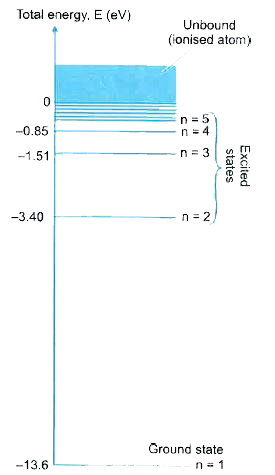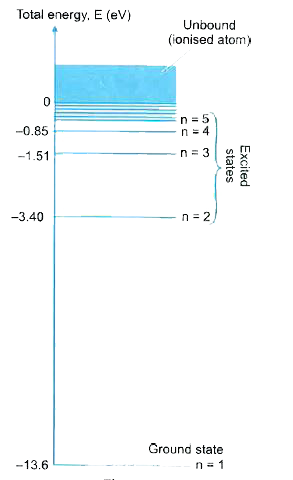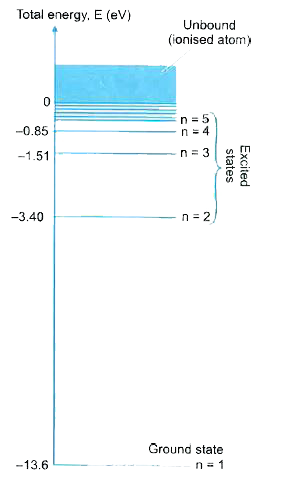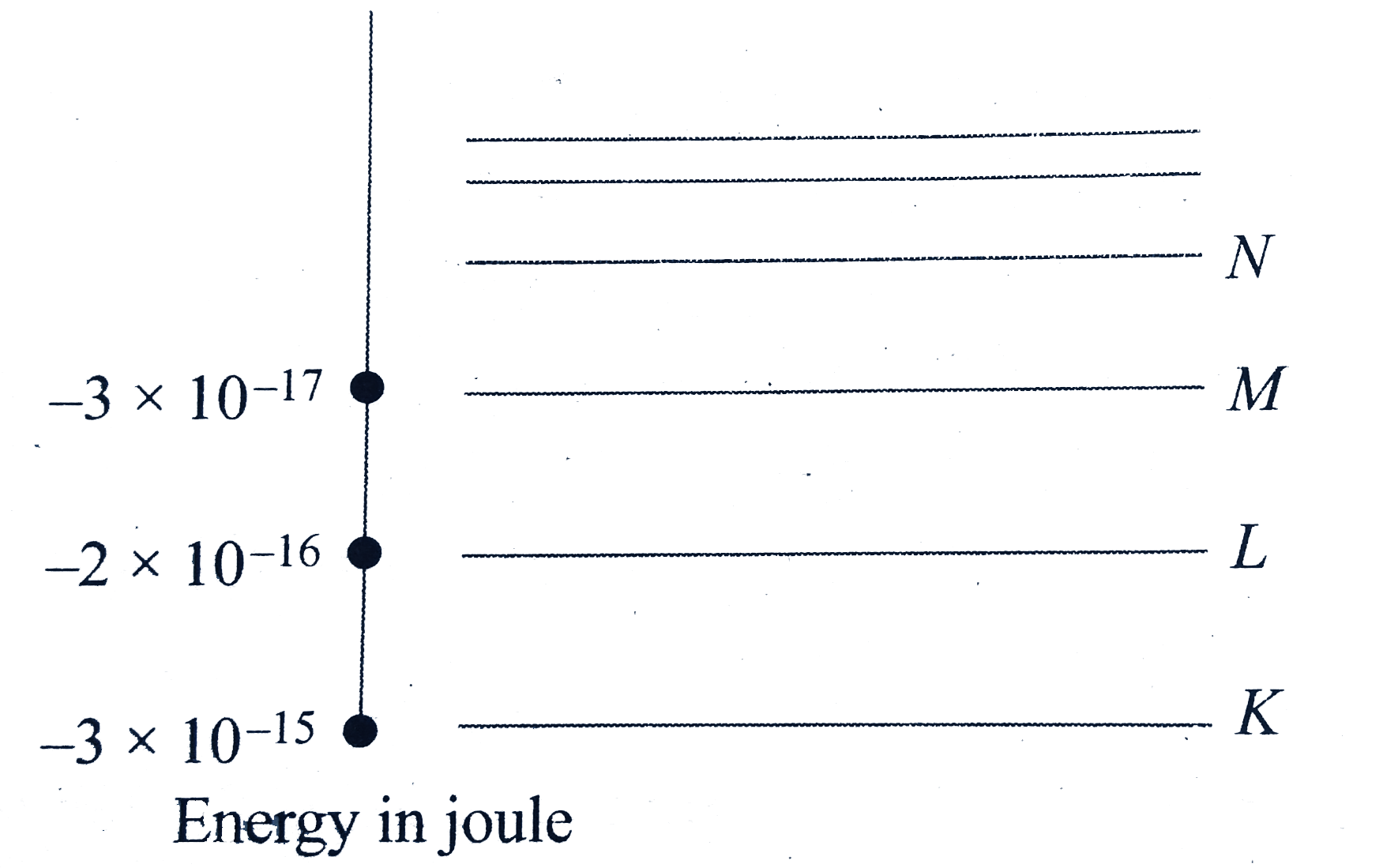The electrons in a - atom kept at rest , jumps from the mth shell to the nth shell . Suppose instead of emitting electromagnetic wave, the energy released is converted into kinetic energy of the atom. Assuming Bohr's model and conservation of angular momentum are valid. Now , answer the following questions:
If the above comprehension be true , ehat is not valid here?
All of them
The correct Answer is:D
Since no external force and tarque act on the atom , still it gets an acceleration and angular acceleration. So, none is true.
Topper's Solved these Questions
- ATOMIC PHYSICSBook:CENGAGE PHYSICSChapter:ATOMIC PHYSICSExercise:Integer
Explore 4 Videos
- ATOMIC PHYSICSBook:CENGAGE PHYSICSChapter:ATOMIC PHYSICSExercise:Fill In The Blanks
Explore 8 Videos
- ATOMIC PHYSICSBook:CENGAGE PHYSICSChapter:ATOMIC PHYSICSExercise:Multiple Correct
Explore 13 Videos
- ALTERNATING CURRENTBook:CENGAGE PHYSICSChapter:ALTERNATING CURRENTExercise:QUESTION BANK
Explore 65 Videos
- ATOMSBook:CENGAGE PHYSICSChapter:ATOMSExercise:QUESTION BANK
Explore 40 Videos
Similar Questions
An electron in an H-atom kept at rest , jumps from the nth shell to the nth shell (m>n). Suppose instead of emitting electromagnetic wave, the energy reased is converted into the kinetic energy of the atom. Assume the Bohr model and convervation of angular momentum are valid. If l is the moment of inertia the angular valocity of the atom about the nucleus is 4(m−n)h/kl. Calculate k
View SolutionRead the pasage given below as well as the adjoining energy level diagram and then answer the questions given after the passage .
As per Bohr's theory og hydrogen atom the energy of an atom in a state corresponding to principal quantum number n is given as :
En=−13.6n2eV
The energy of an atom is the least when its electron is revolving in an orbit closets to the nucleus i.e., the one for which n =1. This state is called the ground state. When a hydrogen atom receives energy by processes such as electron collision , the atom may acquire sufficient energy to raise the electron to higher energy states and the atom is then said to be in an excited state . From these excited states the electron can then fall back to a state of lower energy , emitting a photon in the process.
The energy level diagram for the stationary states of a hydrogen atom , compouted from Bohr's relation for energy , is given in Fig.12.02. The principal quantum number n labels the stationary states in the ascending order of energy . Obviously , the highest energy corresponds to n=∞ and has an energy of 0 eV. This is the energy of the atom when the electron is completely removed (r=∞) from the nucleus and is at rest.

Now answer the follwoing questions:
Find a relation between wavelengths of first line and series limit of hydrogen spectrum in vissible light.
View Solution
Knowledge Check
The electrons in a H- atom kept at rest , jumps from the mth shell to the nth shell (m>n). Suppose instead of emitting electromagnetic wave, the energy released is converted into kinetic energy of the atom. Assuming Bohr's model and conservation of angular momentum are valid. Now , answer the following questions:
What principal is violated of inertiaALaws of motionBEnergy conservationCNothing is violatedDCannot be decidedThe electrons in a H- atom kept at rest , jumps from the mth shell to the nth shell (m>n). Suppose instead of emitting electromagnetic wave, the energy released is converted into kinetic energy of the atom. Assuming Bohr's model and conservation of angular momentum are valid. Now , answer the following questions:
Calculate the angular velocity of the atom about the nucleus if l is the momentum of inertiaA(m+n)6.28hlB(m+n)1.57hlC(m−n)6.28hlD(m−n)1.57hlIn a mixture of He⊕ gas H atom and He⊕ ions Are excited to three respective first excited subsepuenly , H atom transfers its total excitation energy to He⊕ions by collision .Assuming that Bohr model of an atom is applicable , answer the following question
When an electron of H jumps from a higher to lower energy state ,thereAIts potential energy decreasesBIts kinetic energy increasesCIts angular momentum remain unchangedDWavelength of de Broglie wave associated with the electron decrease
Read the pasage given below as well as the adjoining energy level diagram and then answer the questions given after the passage .
As per Bohr's theory og hydrogen atom the energy of an atom in a state corresponding to principal quantum number n is given as :
En=−13.6n2eV
The energy of an atom is the least when its electron is revolving in an orbit closets to the nucleus i.e., the one for which n =1. This state is called the ground state. When a hydrogen atom receives energy by processes such as electron collision , the atom may acquire sufficient energy to raise the electron to higher energy states and the atom is then said to be in an excited state . From these excited states the electron can then fall back to a state of lower energy , emitting a photon in the process.
The energy level diagram for the stationary states of a hydrogen atom , compouted from Bohr's relation for energy , is given in Fig.12.02. The principal quantum number n labels the stationary states in the ascending order of energy . Obviously , the highest energy corresponds to n=∞ and has an energy of 0 eV. This is the energy of the atom when the electron is completely removed (r=∞) from the nucleus and is at rest.

Now answer the follwoing questions:
How can a hydrogen atom receive energy to raise the electron to higher energy states ?
View SolutionRead the pasage given below as well as the adjoining energy level diagram and then answer the questions given after the passage .
As per Bohr's theory og hydrogen atom the energy of an atom in a state corresponding to principal quantum number n is given as :
En=−13.6n2eV
The energy of an atom is the least when its electron is revolving in an orbit closets to the nucleus i.e., the one for which n =1. This state is called the ground state. When a hydrogen atom receives energy by processes such as electron collision , the atom may acquire sufficient energy to raise the electron to higher energy states and the atom is then said to be in an excited state . From these excited states the electron can then fall back to a state of lower energy , emitting a photon in the process.
The energy level diagram for the stationary states of a hydrogen atom , compouted from Bohr's relation for energy , is given in Fig.12.02. The principal quantum number n labels the stationary states in the ascending order of energy . Obviously , the highest energy corresponds to n=∞ and has an energy of 0 eV. This is the energy of the atom when the electron is completely removed (r=∞) from the nucleus and is at rest.

Now answer the follwoing questions:
Define ionisation energy of hydrogen atom and give its value.
View SolutionIn a mixture of HeΘ gas H atom and HeΘ ions Are excited to three respective first excited subsepuenly , H atom transfers its total excitation energy to HeΘions by collision .Assuming that Bohr model of an atom is applicable , answer the following question The quantum number n of the statement finaly populated is HeΘ ion is .
View SolutionThe electron in a Li++ ion is the nth shell , n being very large. One of the K-electron in another matallic atom has been knocked out. The second matel has four orbits. Now, we take two sample one of Li++ ion and the other of the second mateillic ions. Suppose the probability of electronic transition from higher to lower energy level is directly proportional to the energy difference between the two shells. Take hc=1224eVnm , where h is Planck's constant and c the velocity of light in vacuum. It is found that major electromagnetic wavws emitted from the two sample are identical. Now , answer the following questions:
The wavelength of this major X-ray is
View SolutionSimplified model of electron energy levels for a cartain atom is shown in figure. The atom is bombarded will fast moving electrons. The impact of one of these electrons can cause the removal of electron from K-level , thus, creating a vacancy in the K-level. This vacancy in K-level is filled by an electron from l-level and the energy reased in this transition can either appear as electromagnetic waves or may all be used knock out an electron from M-level of the atom.

Based on above information, answer the following question:
Wavelength of the electromagnetic waves emitted due to transition from L to K-level is
View Solution